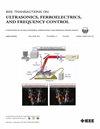Selective Subnucleus Ultrasound Stimulation Induces Synaptic Potentiation in the Mouse Hippocampus
IF 3.7
2区 工程技术
Q1 ACOUSTICS
IEEE transactions on ultrasonics, ferroelectrics, and frequency control
Pub Date : 2025-01-20
DOI:10.1109/TUFFC.2025.3531971
引用次数: 0
Abstract
Ultrasound neuromodulation enables to elicit of long-lasting effect on neural activities and behavioral responses across species, including humans. However, the potential biophysical mechanism of ultrasound stimulation to induce neuroplasticity is still unclear. In this study, we developed a miniature, high target-specificity ultrasound neuro-stimulation chip to selectively stimulate subnucleus and investigate the synaptic plasticity induced by ultrasound stimulation in mouse hippocampal slices. The design of the narrow aperture planar interdigital transducers (IDTs) could reach a 1.3-mm acoustic beam to precisely stimulate the presynaptic CA3 neurons. Acoustic long-term potentiation (A-LTP) was induced by the ultrasound neuro-stimulation chip with 1-ms pulsed duration and different acoustic pressures at 100-Hz repetition frequency [100-Hz low-intensity pulsed ultrasound stimulation (LIPUS)] in the CA3 subregion. Synaptic plasticity was measured by the slope of field excitatory postsynaptic potentials (fEPSPs), which were elicited using bipolar electrical stimulation (ES) electrodes in the Schaffer collaterals of CA3 region and recorded in postsynaptic CA1 neurons using extracellular electrodes. The LTP induced by ultrasound was compared to conventional 100-Hz tetanic ES (100-Hz ES). Our results confirmed that ultrasound stimulation of CA3 significantly induces LTP-like synaptic plasticity when the applied acoustic pressure was 1.08 MPa. The success rate of A-LTP and the average weight of synaptic potentiation level were significantly increased with the increment of acoustic pressure. Moreover, A-LTP was mainly due to the mechanical effects of acoustic waves, but not the thermal or cavitation effects. These results demonstrated that the high-precision ultrasound neuro-stimulation chip can selectively modulate the neural activities in the subnuclear brain region to induce synaptic potentiation, clarifying the biophysical mechanism of A-LTP.选择性亚核超声刺激诱导小鼠海马突触增强。
超声神经调节能够对包括人类在内的物种的神经活动和行为反应产生持久的影响。然而,超声刺激诱导神经可塑性的潜在生物物理机制尚不清楚。在本研究中,我们开发了一种微型、高靶向特异性的超声神经刺激芯片,选择性刺激小鼠海马亚核,研究超声刺激引起的突触可塑性。设计的窄孔径平面指间换能器可以达到1.3 mm的声束,精确刺激突触前CA3神经元。采用超声神经刺激芯片,在100 Hz重复频率(100 Hz LIPUS)下,以1 ms脉冲持续时间和不同声压诱导CA3亚区的声长期增强(A-LTP)。利用双极电刺激电极在CA3区Schaffer侧枝处激发场兴奋性突触后电位(fEPSPs)的斜率来测量突触可塑性,并利用细胞外电极记录CA1神经元的突触后电位。将超声诱发的LTP与常规100hz强电刺激(100hz ES)进行比较。我们的研究结果证实,当声压为1.08 MPa时,超声刺激CA3可显著诱导ltp样突触可塑性。随着声压的增加,A-LTP的成功率和突触增强能级的平均权重显著增加。此外,A-LTP主要是由于声波的力学效应,而不是热效应或空化效应。这些结果表明,高精度超声神经刺激芯片可以选择性地调节脑亚核区神经活动,诱导突触增强,阐明了A-LTP的生物物理机制。
本文章由计算机程序翻译,如有差异,请以英文原文为准。
求助全文
约1分钟内获得全文
求助全文
来源期刊
CiteScore
7.70
自引率
16.70%
发文量
583
审稿时长
4.5 months
期刊介绍:
IEEE Transactions on Ultrasonics, Ferroelectrics and Frequency Control includes the theory, technology, materials, and applications relating to: (1) the generation, transmission, and detection of ultrasonic waves and related phenomena; (2) medical ultrasound, including hyperthermia, bioeffects, tissue characterization and imaging; (3) ferroelectric, piezoelectric, and piezomagnetic materials, including crystals, polycrystalline solids, films, polymers, and composites; (4) frequency control, timing and time distribution, including crystal oscillators and other means of classical frequency control, and atomic, molecular and laser frequency control standards. Areas of interest range from fundamental studies to the design and/or applications of devices and systems.

 求助内容:
求助内容: 应助结果提醒方式:
应助结果提醒方式:


